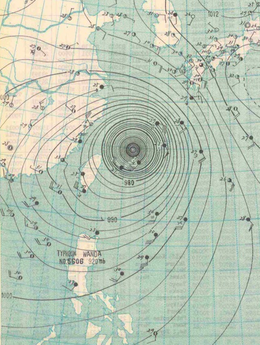This is an old revision of this page, as edited by Jmertel23 (talk | contribs) at 14:43, 8 August 2020 (–{{Stub}}, +{{Weather-stub}} using StubSorter). The present address (URL) is a permanent link to this revision, which may differ significantly from the current revision.
Revision as of 14:43, 8 August 2020 by Jmertel23 (talk | contribs) (–{{Stub}}, +{{Weather-stub}} using StubSorter)(diff) ← Previous revision | Latest revision (diff) | Newer revision → (diff)| Category 5 super typhoon (SSHWS) | |
 | |
| Formed | July 25, 1956 |
|---|---|
| Dissipated | August 5, 1956 |
| Highest winds | 1-minute sustained: 295 km/h (185 mph) |
| Lowest pressure | 915 hPa (mbar); 27.02 inHg |
| Fatalities | 4,935 death |
| Areas affected | China |
| Part of the 1956 Pacific typhoon season | |
Super Typhoon Wanda was a Super typhoon caused catastrophic damage to China in 1956.
Meteorological history

A tropical depression developed southwest of Guam on July 25. It moved north-northeastward, passing east of the Northern Marianas. On July 27, it intensified into a tropical storm and was designated Wanda. On the same day, the storm turned more westward, steered by the subtropical ridge to the north. Low wind shear and warm waters allowed Wanda to intensify steadily, developing into an intense typhoon while . On July 30, reconnaissance aircraft recorded a minimum pressure of 902 mbar (26.6 inHg), and the peak winds were estimated at 295 km/h (185 mph). After passing through the Miyako Islands, Wanda weakened slightly and traversed the East China Sea. On August 1, the typhoon made landfall in eastern China near Zhoushan, Zhejiang, producing a pressure of 923 mbar (27.3 inHg); this was the lowest pressure recorded in China from a tropical cyclone. Wanda slowly weakened while progressing through China, dissipating on August 5.
Impact
Taipei on Taiwan recorded 297.3 mm (11.70 in) of rainfall over three days while the typhoon passed to the north. Along the coast of Zhejiang, Wanda produced a 5.02 m (16.5 ft) storm surge that destroyed 465 seawalls and 902 boats. The storm also flooded crop fields, destroying 20,380 tons of wheat. Across Zhejiang, 2.2 million houses and 38.5% of the main roads were damaged during the storm. Nationwide, Wanda killed 4,935 people and injured 16,617 others.
Damage by Wanda
External links
References
- Japan Meteorological Agency (June 1, 1989). "RSMC Best Track Data - 1951-1959". Archived from the original (TXT) on March 22, 2012. Retrieved December 21, 2016.
- ^ Peijun Shi, ed. (2016). Natural Disasters in China. Nature. p. 123-126.
This article related to a specific weather event is a stub. You can help Misplaced Pages by expanding it. |

